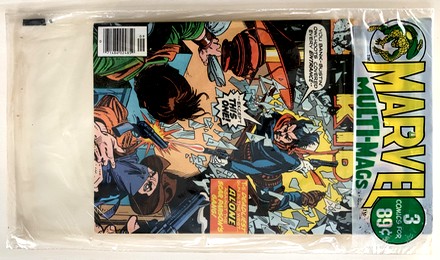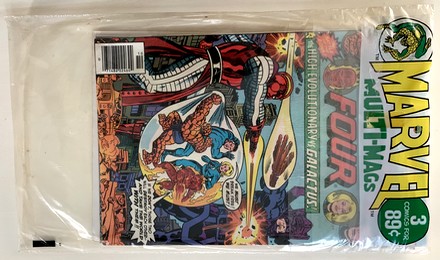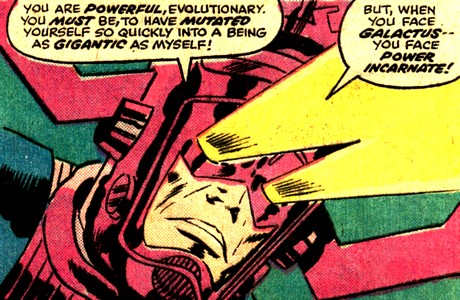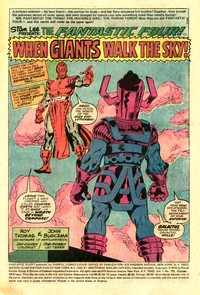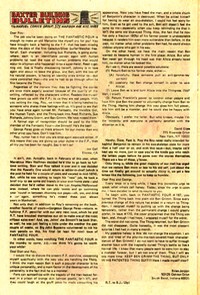 |
 |
|
MARVEL
MULTI-MAGS TRIVIA
THE
PECULIAR CASE OF THE
1976/77
"YELLOW & GREEN ON
WHITE" LABELS

|
|
|
|
| |
|
| |
| |
MARVEL
MULTI-MAGS
|
|
In the early
1960s, the comic book industry
witnessed two radically different
developments. On the one hand, it
saw the hugely successful
comeback of the superhero genre
(which had been clinically dead
for most of the 1950s) and a
subsequent streak of new
creativity which was met with an
almost unprecedented enthusiasm
for the medium. On the other
hand, the industry's traditional
sales points were fading away, as
small stores which had carried
comic books for decades were
being pushed out of business by
larger stores and supermarkets.
At the same time, newsagents were
increasingly viewing the low
cover prices and therefore tiny
profit margins comics had to
offer as a
nuisance. Many ideas on how
to turn these developments around
were put forward by different
publishers, but the most
successful concepts strived to
open up new sales opportunities
and markets and thus tap into a
new customer base.
|
|
|
|
| |
| One place these potential buyers could be
found was the growing number of supermarkets and chain
stores. But in order to be able to sell comic books at
supermarkets, the product would have to be adjusted. |
| |
| Handling individual issues
clearly was no option for these outlets, but by
looking at their logistics and display
characteristics, DC Comics (who came up with the Comicpac
concept in 1961) found that the answer to
breaking into this promising new market was to
simply package several comic books together in a
transparent plastic bag. This resulted in a
higher price per unit on sale, which made the
whole business of stocking them much more
worthwhile for the seller. The simple packaging
was also rather nifty because it clearly showed
the items were new and untouched, while at the
same time blending in with other goods sold at
supermarkets (most of which were also
conveniently packaged). |
|
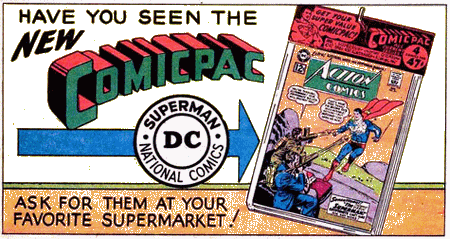 |
|
| |
| Outlets
were even supplied with dedicated Comicpac
racks, which enhanced the product appeal even more since
the bags containing the comic books could be displayed on
rack hooks in an orderly and neat fashion. |
| |
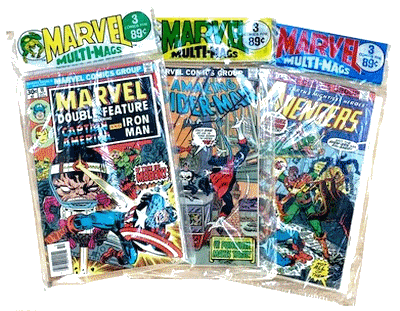
|
|
DC's
"comicpacks" were a success -
so much so that other publishers quickly
started to copy it. Marvel produced a
series of Marvel Multi-Mags in
1968/69 but then seems to have dropped
the idea again. However, by the
mid-1970s, the House of Ideas had
once again fully embraced the marketing
concept of selling multiple comic books
packaged in a sealed plastic bag to a
customer base which comic books could
hardly reach otherwise: people shopping
at supermarkets and large grocery stores.
It didn't really matter therefore that
buying these three comic books in a
comicpack for say 89¢ (rather than from
a newsagent for 90¢
in that case)
clearly presented no real bargain - it
was the opportunity and convenience to
pick up a few comics at the same time
parents and adults did their general
shopping. Neatly packaged, it almost
became an entirely different class of
commodity.
|
|
|
| |
| When Marvel reintroduced its MARVEL MULTI-MAGS in late 1972, the label at the top of the
plastic bags underwent a design change which would be
used consistently up until the early 1980s. If featured the product's name in
central position (also emphasizing that these were MARVEL
comics) and two roundels on each side, featuring a
classic John Romita Sr. Spider-Man pose to the left and
the content and price information (such as 3 comics
for 89¢) to the right. 
While the first two elements
never changed, the third roundel had to be adjusted
whenever there was a price increase (or, far less
frequently, a change in the number of comic books
contained). Such a change would often be
accompanied by a change of colours used on the labels,
and it seems that Spidey's costume was popular and
well-known enough to withstand even the most garish
colour combinations. As a result, there are roughly half
a dozen different colour combinations between 1972 and
1983 (some of which would be used repeatedly), so the
reason why the "yellow and
green on white label / 3 comics for 89¢" stands out
has nothing to do with its colour combination, but rather
with the way bags with this label were sealed.
THE
PECULIAR CASE OF THE
"YELLOW & GREEN ON WHITE LABEL / 3 COMICS FOR
89¢"
MARVEL
MULTI-MAGS
|
| |
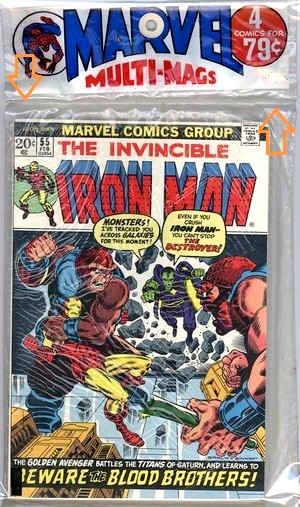
|
|
Other
than obviously having a sealed top and,
once the comic books were inserted, a
sealed bottom, the polybags used for
Marvel's MULTI-MAGS also had a third seal line
below the label, as indicated by the
arrows in the example shown here (a
February 1973 MULTI-MAGS containing 4 comics for
79¢). 
Heat sealing the bag at this point
served two purposes. On the one hand, it
provided a somewhat strengthened label
(which of course also doubled as a hanger
for most displays, which explains the
"strenthener rings" applied to
earlier MULTI-MAGS). On the other hand, it
provided a tighter fit for the comic
books by restricting their vertical
movement inside the bag.
All the bags
used by Marvel for their MULTI-MAGS followed this pattern (as
did those of most publishers putting out
comicpacks at the time), but when a new
label had to be produced to reflect an
increase of price from "3 comics for
74¢" to "3 comics for
89¢" as of October 1976 (after
Marvel had raised the cover price for its
standard comic books from 25¢ to 30¢ in
September 1976), something strange
happened.
In effect, the
new label used - which was white with
yellow and green printing and priced the
3 comics at 89¢ - lacked the third seal
line.
|
|
|
| |
| Although
sealed around the edges (shown here, below, with the
green line, #1) like any and all other polybags used for MULTI-MAGS, the lack of this third seal
line (the red line, #2) was caused by the topmost quarter
of the polybag's length (including the label) actually
forming a slip-over fold (the arrows are pointing to the
bottom edge of this, #3). Depending on whether this
overhang came to end up inside the polybag or on its
outside (examples of both are known) resulted in two
entirely different effects on how enclosed the comic books
contained in such a polybag were. |
| |
| If the fold ended up inside
the polybag, the contents of that MULTI-MAGS were, to all intents
and purposes, sealed inside, since the overhang
covered the top quarter of the comic books from
inside the polybag; the sealed side edges made it
virtually impossible to insert or extract
anything from that bag without clear tell-tale
signs such as creases. However, if the fold
ended up outside the polybag, it wasn't
fully enclosed and remained open for the entire
width of the plastic bag (orange circle).
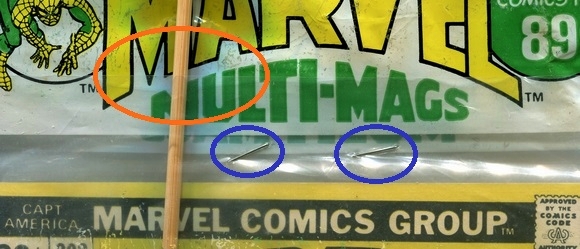
Some MULTI-MAGS with this problem have
been "fixed" by stapling the bag below
the label where the the sealing line would
normally be (blue circles), but there is no
telling at what point in time and by whom those
staples were attached.
|
|
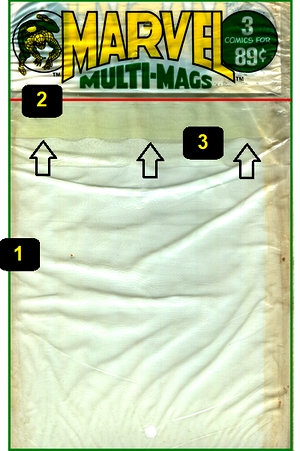 |
|
| |
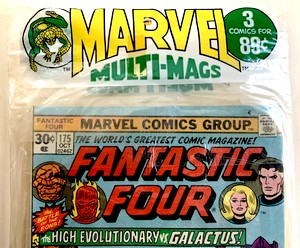 |
|
If
the fold was on the inside of the polybag - as is
the case in the example shown here - there was no
need for staples. But visuals aside, the lack
of the sealing line below the label results in a
major fault with regard to how well the packaging
protects its contents, since the comic books
inside a MULTI-MAGS
polybag of this type
are not restricted from moving about into the
label part of the sealed bag - quite unlike those
packaged inside a "regular" MULTI-MAGS polybag (i.e. with a sealed off
label).
|
|
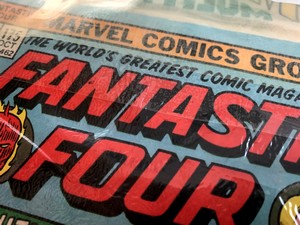 |
|
| |
|
| |
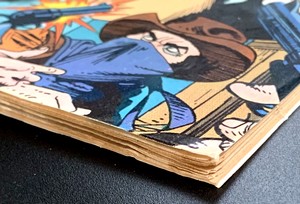
|
|
The
potential physical damage which can
result in repeated such movement (which
could have occured frequently even during
the original packaging, shipping, storing
and handling throughout) can easily be
seen with the two outer comic books of
this specific MULTI-MAGS example; in
spite of having been contained in a
sealed polybag, they both display major
blunting and scuffing to the bottom and
top of their pages. Another clear
indication that this damage is due to
vertical movement inside the bag is the
fact that the comic book in the middle - Marvel
Premiere #32 - is virtually in
pristine condition, having been somewhat
cushioned and protected by the two outer
comic books.
|
|
|
| |
| The presence of the
aforementioned staples may have added additional
confusion to the nature and, to a degree, even
authenticity of MARVEL MULTI-MAGS bearing the "yellow and green on white / 3
comics for 89¢" label. A number of these 3-packs
show up regularly at online auction sites and are often
described by (cautious) sellers as "unopened"
rather than "sealed". And since these
polybags differ so prominently from regular MARVEL MULTI-MAGS ones, a certain aura of suspicion remains
- could they even have been tampered with? There is
sufficient evidence to show that this type of bag was
indeed used for actual MARVEL MULTI-MAGS for a period of around six
months between October 1976 and Spring 1977. The
shortcomings of this type of polybag would however
not have gone unnoticed (correctly sealed bags with green
and blue labels were used concurrently as early as late
October 1976), and it seems that the culprits were phased
out long before actual stocks were depleted - a fact
which can be deduced from the number of unused polybags
of this type still being offered for purchase (often on
the same online auction sites as the actual MULTI-MAGS for
which those polybags were used at the time).
|
| |
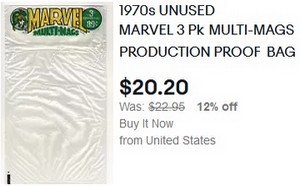 |
|
The
regular availability of these "production
proof bags" does, however, also mean that
anybody can easily insert anything into those
polybags and then seal them - a task easily
accomplished, and something which was in fact a
common practice in the early 1980s and 1990s.
"Distributors (...) were able to
buy empty Whitman plastic bags & they
could fill them with random leftover comics
& then heat seal them." (Stl
Comics, 2006)
Given the availability of unused "yellow and green on white /
3 comics for 89¢" labelled polybags for,
assumedly, decades, such a practice is at least
something that needs to be considered and taken
into account.
|
|
| |
| Most
of the comicpacks filled and sealed by third parties at
some later point in time often display one or more
tell-tale signs, such as containing comic books from
mixed publishers (Metarog, 2006) or titles from different
years (Stl Comics, 2006), making it all but obvious that
they are not from the original packing and distribution
process. A few "yellow and
green on white / 3 comics for 89¢" MARVEL MULTI-MAGS do, however, pose a slightly more subtle
conundrum, and the example we will be looking at in more
detail here is a point in case. As a general
(and extremely reliable) rule, MARVEL
MULTI-MAGS not only contain issues
from the same cover date production month only, but
issues which actually went on sale the same day or within
a week or two of each other - and there are examples of
late 1976 and early 1977 MULTI-MAGS
with a "yellow
and green on white / 3 comics for 89¢" label which
conform perfectly to this rule. In
contrast, the dates of the issues contained in this
example MULTI-MAGS vary quite a bit:
- Ringo Kid #29: cover date September
1976, on sale 22 June 1976, bi-monthly
- Marvel Premiere #32: cover date October
1976, on sale 6 July 1976, bi-monthly
- Fantastic Four #175: cover date October
1976, on sale 27 July 1976, monthly
So is this simply a rare case of an
exception to the rule - after all, most rules have them?
Answering that question is extremely
difficult, not the least because the "rules"
behind Marvel's Multi-Mags are extremely hard to make
out. Unlike rival DC, whose equivalent Super Pacs
were published throughout the 1970s and early 1980s in a
very orderly fashion (which, for example, lets us know
that the rule was to publish four Super Pacs
every month), Marvel's Multi Mags didn't seem to follow
any hard publishing rules at all - or at least the
available data doesn't allow us to see them today.
At least the relative closeness of the
publication dates of the three issues raises less
suspicion than one or two other known cases of "problem
polybag" MULTI-MAGS which contain issues which are even several
months apart in terms of cover dates. Ultimately,
however, we may never know if any tomfoolery was involved
or not.
Either way, the case of the "yellow and green on white / 3
comics for 89¢" labelled MARVEL
MULTI-MAGS remains a peculiar one.
The main question it raises is not, however, whether or
not they are sealed, but rather who sealed them,
and when.
And just to make things even more
confusing - Marvel had already had the same problem with
a MARVEL MULTI-MAGS polybag before, with the culprit being a
handful of "red and blue on white / 3 comics for 74¢" labelled ones -
while the vast majority of bags with that label were
actually sealed correctly. But that is definitely a story
for some other time...
|
| |
| Here
are some known examples of MARVEL
MULTI-MAGS with the "yellow and green on white / 3
comics for 89¢" label; the price tag for MARVEL MULTI-MAGS was 89¢ from
October 1976 until December 1977. |
| |
OCTOBER 1976
|
MARVEL
MULTI-MAGS (3 for 89¢)
Fantastic
Four #175
Marvel Premiere #32
Ringo Kid #29
|
Contains a mix of
cover date months: September 1976 (Ringo Kid #29)
and October 1976 (Fantastic
Four #175, Marvel Premiere #32).
Only the second known Western
title to feature in a MARVEL
MULTI-MAGS.
Likewise, this is only the second
known instance of an issue of Marvel Premiere being
packaged in a MARVEL
MULTI-MAGS.
|
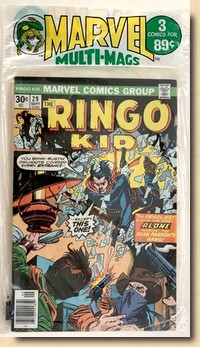 |
| |
|
|
|
OCTOBER 1976
|
MARVEL
MULTI-MAGS (3 for 89¢)
Marvel
Double Feature #18
Daredevil #138
Marvel Super-Heroes #60
|
All issues carry the same cover
date (October 1976). This is the only known
instance of an issue of Marvel Double Feature being
packaged in a MARVEL
MULTI-MAGS, while the two other titles
were featured often and regularly.
|
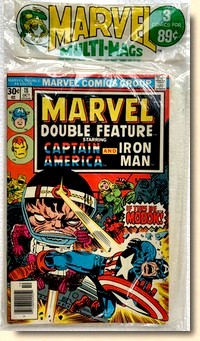 |
| |
|
|
|
OCTOBER
1976
|
MARVEL
MULTI-MAGS (3 for 89¢)
Master
of Kung Fu #45
Tomb of Dracula #49
Marvel Spotlight #30
|
All issues carry the same cover
date (October 1976). All three titles are
rarely featured in MARVEL
MULTI-MAGS.
There is a concurrent
MARVEL MULTI-MAGS with a
green title label which also features Marvel Spotlight #30
but instead of Master of Kung Fu #45
and Tomb of Dracula #49 carries Daredevil
#138 and Ka-Zar #18.
|
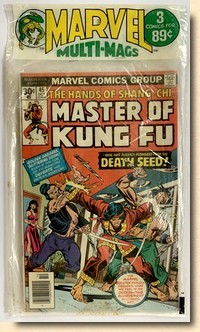 |
| |
|
|
|
JANUARY
1977
|
MARVEL
MULTI-MAGS (3 for 89¢)
Avengers
#155
Thor #255
Marvel Triple Action #33
|
All issues carry the same cover
date (January 1977). All three titles were
regularly packaged into MARVEL
MULTI-MAGS.
A second
example of this MARVEL
MULTI-MAGS is known to exist, albeit with Thor and Avengers
as the issues facing the outside of the polybag.
|
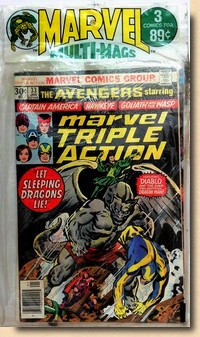 |
| |
|
|
|
FEBRUARY 1977
|
MARVEL
MULTI-MAGS (3 for 89¢)
Captain
America #206
Marvel Tales #75
Ka-Zar #20
|
All issues carry the same cover
date (February 1977). There are a few
instances of Ka-Zar
featuring in a MARVEL
MULTI-MAGS, while both other titles
appeared frequently and regularly in Marvel's
threepacks.
Several identical examples of this MARVEL MULTI-MAGS are known to
exist.
|
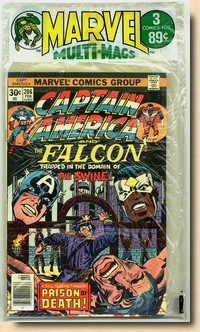 |
| |
|
|
|
|
| |
| |
|
| |
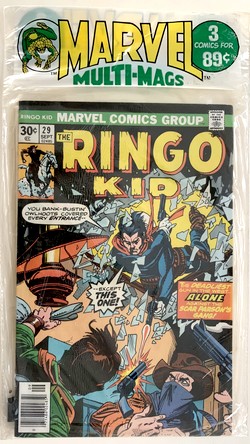 |
|
The MARVEL
MULTI-MAGS we are looking at here features
three titles - Ringo Kid #29, Marvel
Premiere #32, and Fantastic Four #175. As
already pointed out, these are not all from the
same cover date run, with Ringo Kid #29
being the odd one out with a September 1976 cover
date whereas the two other issues are from the
October 1976 publishing run.
The fact that this MARVEL
MULTI-MAGS contains isues from two
consecutive cover date months also means that
there's two for one Bullpen Bulletins: A
Quaff of Quixotic Quips to Quench Your Quakes and
Quanderies! (September 1976) and A
Ragbag of Riotious Repartee for Our Resplendently
Rarified Readership! (October 1976).
Both also feature, of course, Stan's
Soapbox, and in the September edition Stan
Lee gives a shoutout to his brother, Larry Lieber
- and provides US readers with a rare moment of
awareness that the World of Marvel reaches beyond
the Atlantic Ocean:
|
|
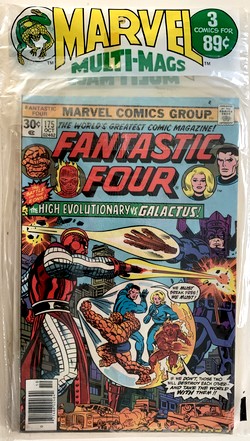 |
|
| |
"Larrupin' Larry
Lieber (...) has also come aboard to handle the
issues which we produce for an ever-growing army of
Marvel fanatics in Great Britain. Wouldja believe
they're on sale weekly over
there; so we're bettin' that Larry'll be kinda
busy."
|
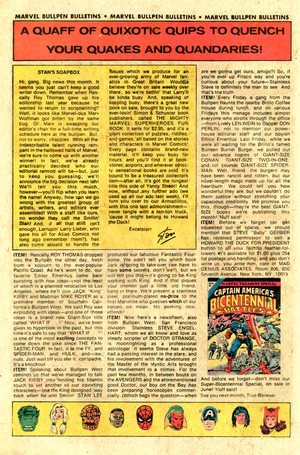 |
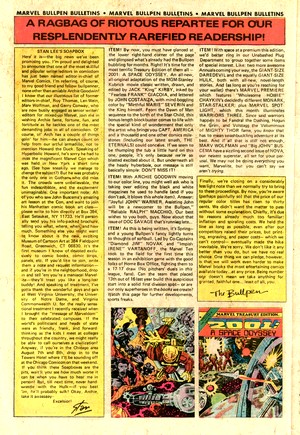 |
|
Lee was
referring to Marvel's own UK imprint,
launched in September 1972 and commonly known as Marvel
UK. However, the fact that the House
of Ideas was popular in the UK and many European
countries could also be glimpsed from the small
ads pages, where an English comic book dealer
advertised his services.
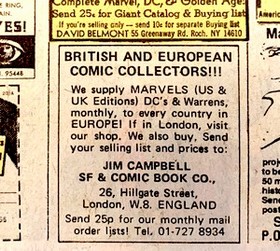
|
|
| |
| |
|
| |
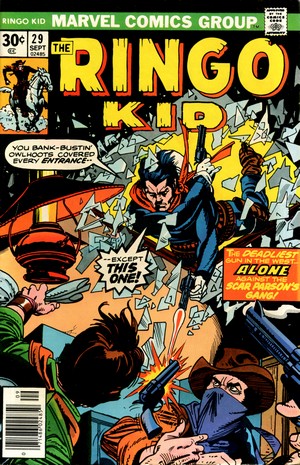
|
|
RINGO KID
#29
September 1976
(bi-monthly)
On Sale: 22 June 1976
Editor
- Archie Goodwin, Roger Stern
(reprint editor)
Cover - Gil Kane
Ringo Kid is one of the
lesser known characters of the Marvel
Western Universe (which includes Rawhide
Kid, Two-Gun Kid and Kid Colt,) who made
his debut in the 1950s Atlas Western
comics range, created by an
unknown writer and artist Joe Maneely.
Dressed all in black, the Ringo Kid
is a 19th
century Old West gunslinger who is
treated as an outcast because of his
mixed heritage (being the son of a
Caucasian father and a Native American
mother) and the fact that he is on the
run after being wrongly accused of a
crime. His sidekick is Dull Knife, a
warrior from his mother's tribe, and his
horse is named Arab. The Ringo Kid is
essentially an outlaw who isn't one and
strives for just law enforcement while
observing a vow of not to kill.
Marvel reprinted material from the
original series in Ringo Kid (vol.
2) over a run of 30 issues from January
1970 to November 1976. Ringo Kid #29,
the penultimate issue of the series,
features three Ringo Kid and one
unrelated stand-alone stories.
|
|
|
| |
| None of the material reprinted in Ringo Kid #29
carries any indication as to its original publication,
which for all four stories is Ringo
Kid Western #19 (July 1957). |
| |
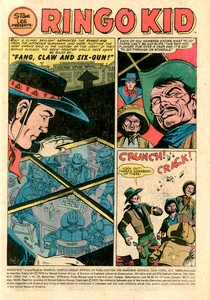 Fang, Claw and Six-Gun!
(5 pages)
Writer unknown
Art by Joe Maneely
|
|
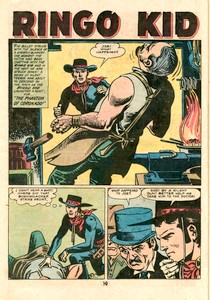 The Phantom of
Coronado
(5 pages)
Writer unknown
Art by Joe Maneely
|
|
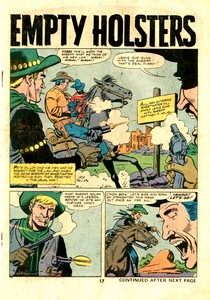 Empty Holsters
(4 pages)
Writer unknown
Art by Jack Keller (signed)
|
|
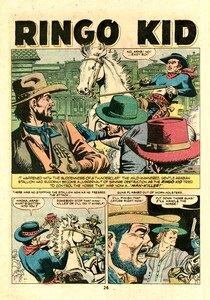 Man-Killer!
(5 pages)
Writer unknown
Art by Joe Maneely
|
|
| |
| |
 |
|
Question marks
regarding this "yellow and
green on white" MULTI-MAGS aside, there is only
one other example of a MULTI-MAGS known so far containing a
Western title - a June 1976 pack
featuring
Mighty Marvel Western #45 (together with Ghost
Rider #18 and Black
Goliath #3). The
Ringo Kid even made it into the
present day Marvel Universe -
together with Rawhide Kid,
Two-Gun Kid, Kid Colt and Night
Rider - in a time travel plot
featured in Avengers #142
(December 1975).
|
|
|
|
| |
| |
|
| |
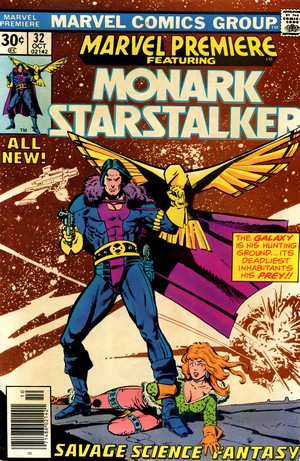
|
|
MARVEL
PREMIERE
#32
October
1976
(bi-monthly)
On Sale: 6 July 1976
Editor - Archie
Goodwin
Cover - Howard Chaykin (pencils)
& Al Milgrom (inks)
"Monark
Starkstalker"
(17 pages)
Story
- Howard Chaykin
Pencils - Howard Chaykin
Inks - Howard Chaykin
Lettering - Annette
Kawecki, Jim Novak
Colouring - Glynis Wein
Marvel Premiere was one
of three "tryout
titles" launched at the time
of Stan Lee's promotion from
writer and editor to president
and publisher (the others being Marvel
Spotlight and Marvel
Feature).
The purpose of such tryout
books was that they gave the
publisher a means to assess a
feature's popularity without the
marketing investment required to
actually launch a new series
(which also meant that the
financial loss and potential blow
to the publisher's image would be
minimal in case a new character
tanked with readers).
|
|
|
|
| |

|
| |
| Tryout books could thus give established characters a
first shot at a starring role, reintroduce characters who
no longer had their own titles, or introduce
all-new characters. |
| |
But as the letters page of Marvel
Premiere #32 explains, there could be subtle
conceptual differences which set the tryout
titles apart:
"SPOTLIGHT is a try-out book for
previously-introduced Marvel characters, such
as Sub-Mariner, Moon Knight, and the Warriors
Three. In PREMIERE, however, we want to
establish a slightly different bent,
showcasing new ideas and concepts - such as
Bill Mantlo's furry fellow [i.e. Rocky
Racoon] and Howard Chaykin's manhunter of the
far-flung future."
This had not, however, been the case
originally, as Marvel Premiere #1 (April
1972) featured a revamp of Adam Warlock before
Doctor Strange took over as of Marvel
Premiere #3 (July 1972) for a total of
twelve issues before leaving for his own
re-instated title.
|
|
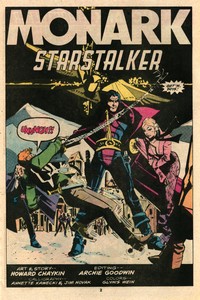 |
|
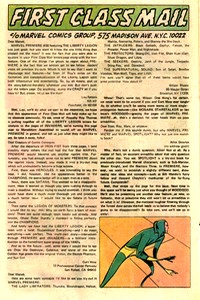 |
|
| |
| The Sorcerer Supreme was followed by new character
Iron Fist who made his debut in Marvel Premiere
#15 (May 1974), who in turn after 13 issues got his own
title. It was really only starting with Marvel
Premiere #26 (November 1975) that the title followed
the route outlined in the letters page of Marvel
Premiere #32, introducing a long line of characters
which would only appear in one or two issues (of which
some of the earlier ones were Woodgod, the legion of
Monsters, or 3-D Man). In the late 1970s, some better
known Marvel characters made an appearance (such as
Ant-Man, Falcon or Black Panther), alternating with some
more outrageous features (such as Alice Cooper). Even
Doctor Who, of TV series fame, got to appear in some of
the last issues, and the final curtian came in August
1981 when Marvel Premiere #61 featured
Star-Lord. |
| |
 |
|
Howard Chaykin's
single-handed creation Monark
Starstalker turned out to be just
a passing stranger in the Marvel
Universe. However, his adventure
from Marvel Premiere #32
was reprinted in early 1978 for
the French market in Eclipso
#62 (albeit in black & white
only), in October 1979 in Italy
for Editoriale Corno's Gli
Eterni #20, and finally in
April 1980 in Marvel UK's Star
Wars Weekly #111-113 (also
in b&w and in three five to
six page segments). This is
only the second known instance of
an issue of Marvel Premiere being
packaged in a MARVEL MULTI-MAGS.
|
|
|
|
| |
| |
|
| |
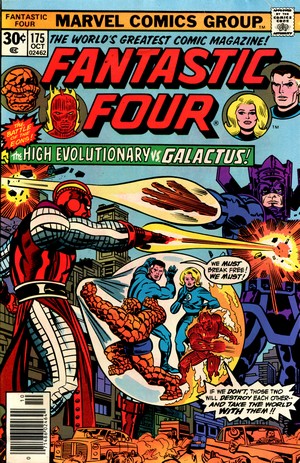
|
|
FANTASTIC
FOUR #175
October
1976
(monthly)
On Sale: 27 July 1976
Editor - Roy
Thomas
Cover - Jack Kirby (pencils)
& Joe Sinnott (inks)
"When
Giants Walk the Sky!"
(17 pages)
Story - Roy
Thomas
Pencils - John Buscmea
Inks - John Buscmea
Lettering - Joe Rosen
Colouring - Janice Cohen
The Fantastic Four and the
High Evolutionary face off
against Galactus, but are saved
in the nick of time by... the
Impossible Man...
Plus: The Thing regains his
full rocky form (the previous
loss of which he had compensated
by wearing an exoskeleton).
|
|
|
|
| |
|
| |
 |
| |
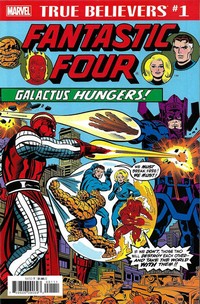 |
|
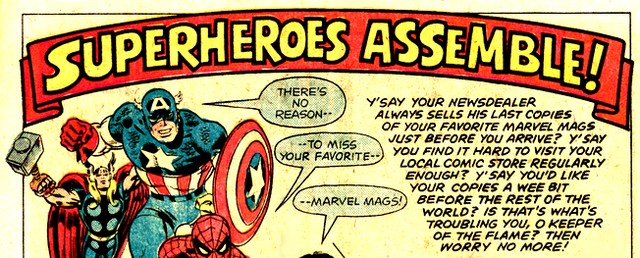
Fantastic
Four #175 was one of many
"classic" FF issues
which Marvel reprinted in
September 2018 as part of their
$1 price tag True Believers
series.
|
|
|
|
| |
| |
|
| |
| FURTHER
READING ON THE THOUGHT
BALLOON |
| |
| |
 |
|
"Comic
packs" not only sold well
for more than two decades, they
also offer some interesting
insight into the comic book
industry's history from the 1960s
through to the 1990s. There's
more on their general history here. |
|
|
|
| |
 |
|
There's more on
the background and the history of
the Marvel Multi Mags here. |
|
|
|
| |
 |
|
There's more on
the background and the history of
Marvel's UK imprint of the 1970s,
commonly referred to as Marvel
UK, here. |
|
|
|
| |
| |
|
| |
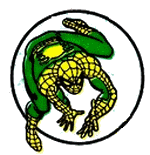
More on comic packs / More on Marvel Multi-Mags
|
| |
|
| |

(c) 2021
uploaded
to the web 22 August 2021
|
| |
|
| |
|














